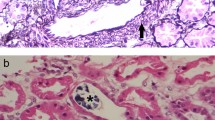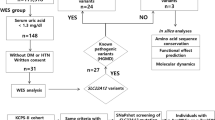Abstract
Recent identification of the urate transporter in the kidney (URAT1, encoded by SLC22A12) led to the molecular elucidation of idiopathic renal hypouricemia, which is a predisposition toward exercise-induce acute renal failure. One Japanese patient with renal hypouricemia demonstrated compound heterozygous mutations of the URAT1 gene (Q297X and IVS2+1G>A). It was suggested that these two mutations are recurrent mutations of the URAT1 gene in a Japanese population. In addition, we expect the prevalence of renal hypouricemia, 0.23%, from the analysis of serum urate levels in 1,730 Japanese children.


Similar content being viewed by others
References
Ohta T, Sakano T, Ogawa T, Kato J, Awaya Y, Kihara H, Kinoshita Y (2002) Exercise-induced acute renal failure with renal hypouricemia: a case report and a review of the literature. Clin Nephrol 58:313–316
Ishikawa I (2002) Acute renal failure with severe loin pain and patchy renal ischemia after anaerobic exercise in patients with or without renal hypouricemia. Nephron 91:559–570
Enomoto A, Kimura H, Chairoungdua A, Shigeta Y, Jutabha P, Cha SH, Hosoyamada M, Takeda M, Sekine T, Igarashi T, Matsuo H, Kikuchi Y, Oda T, Ichida K, Hosoya T, Shimokawa K, Niwa T, Kanai Y, Endou H (2002) Molecular identification of a renal urate-anion exchanger that regulates blood urate levels. Nature 417:447–452
Ichida K, Hosoyamada M, Hisatome I, Enomoto A, Hikita M, Endou H, Hosoya T (2004) Clinical and molecular analysis of patients with renal hypouricemia in Japan-influence of URAT1 gene on urinary urate excretion. J Am Soc Nephrol 15:164–173
Komoda F, Sekine T, Inatomi J, Enomoto A, Endou H, Ota T, Matsuyama T, Ogata T, Ikeda M, Awazu M, Muroya K, Kamimaki I, Igarashi T (2004) The W258X mutation in SLC22A12 is the predominant cause of Japanese renal hypouricemia. Pediatr Nephrol 19:728–733
Iwai N, Mino Y, Hosoyamada M, Tago N, Kokubo Y, Endou H (2004) A high prevalence of renal hypouricemia caused by inactive SLC22A12 in Japanese. Kidney Int 66:935–994
Van Peenen HJ (1973) Causes of hypouricemia. Ann Intern Med 78:977–978
Hisatome I, Ogino K, Kotake H, Ishiko R, Saito M, Hasegawa J, Mashiba H, Nakamoto S (1989) Cause of persistent hypouricemia in outpatients. Nephron 51:13–16
Author information
Authors and Affiliations
Corresponding author
Rights and permissions
About this article
Cite this article
Takahashi, T., Tsuchida, S., Oyamada, T. et al. Recurrent URAT1 gene mutations and prevalence of renal hypouricemia in Japanese. Pediatr Nephrol 20, 576–578 (2005). https://doi.org/10.1007/s00467-005-1830-z
Received:
Revised:
Accepted:
Published:
Issue Date:
DOI: https://doi.org/10.1007/s00467-005-1830-z




